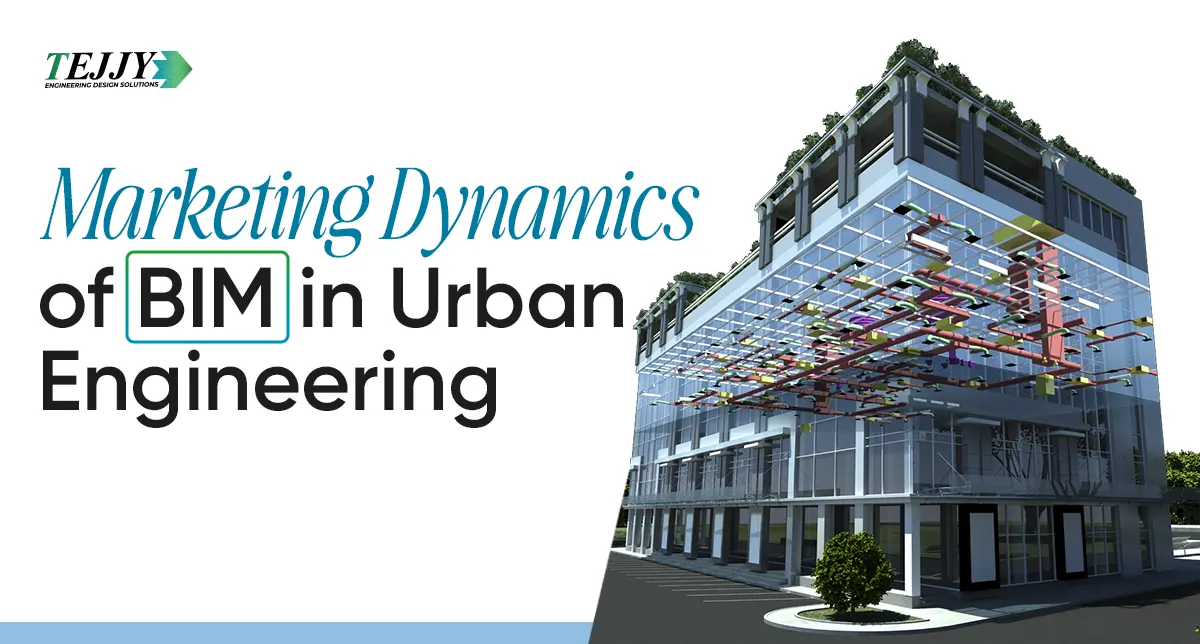
Building Information Modeling (BIM) is a real-world model to facilitate urban engineers and civil engineers in identifying potential problems at the pre-construction stage. The technique of BIM modeling service providers establishes a collaborative process empowered by the creation and exchange of applicable digital information throughout the built asset. 3D BIM modeling companies facilitate the civil engineers to enhance outcomes with the ability to investigate multiple scenarios, providing data-driven assurance.
Currently, the Building Information Modeling market is anticipated to grow from USD 4.5 billion in 2020 to USD 8.8 billion in 2025 at a compound annual growth rate of 14.5%. The significant factors driving the growth of the BIM market consist of increased urbanization along with the development of the infrastructure projects provided by BIM for the AEC sector. Further, an enhanced government mandate for BIM implementation is accelerating the growth of the BIM market.
Pre & post-COVID-19 BIM in Urban Engineering
-
Pre-COVID-19 Situation for the BIM Market:
The BIM market has seen a demand in the pre-COVID-19 set-up. Through the growth of the population and economies, the demand for housing and infrastructure development is expected to fuel the growth of the international construction business. This creates a robust demand for BIM to plan, design, and supervise building projects competently. As a result of which, the 3D model-based BIM methodology is gaining power among architectural, urban engineering, and construction professionals in delivering construction projects and making them successful.
Currently, the growing trends of innovative technologies have led to the growing adoption of pioneering methods in the operational standards of the construction industry. Building Information Modeling constitutes one such tactic of providing benefits like 3D BIM visualization, collaboration, management of design-build solutions and construction planning, clash detection amongst various disciplines, and construction cost reduction. Even if the factors contribute to the growth of the BIM market, it will not reach its earlier projection, i.e., anticipated to reach 9.5 billion in 2025, at a CAGR of 12.7% from 2020 to 2025.
-
Post-COVID-19 Situation for BIM Market:
The COVID-19 pandemic in December 2019 has ensued in the quick spread of the disease in virtually 100 countries across the world. The World Health Organization has acknowledged it to be a public health emergency, and COVID-19 is anticipated to bring a negative impact on the overall BIM market. According to the report of the Associated General Contractors of America, a minimum of 45% of contractors are undergoing delays and disruptions owing to the outbreak. The holdups are caused by the scarcity of materials, quantities, and building equipment. In addition to this, a dearth of skilled labor and construction safety equipment are among a few of the key aspects upsetting the global construction sector.
Moreover, a few building projects are being stopped or delayed due to asymptomatic staff, as there would be a temporary shutdown if any employee is tested COVID-19 positive. Since architectural, engineering, & construction professionals are the biggest end users of the BIM software applications, used frequently in building projects, a postponement or withdrawal of these projects would have a hostile impact on the whole BIM market. The market is expected to improve progressively in the subsequent 2 years and is estimated to reach 8.8 billion by 2025, at a compound annual growth rate of 14.5% from 2020 to 2025.
BIM Market Dynamics
-
Driver of BIM Growth: Rapid Urbanization & Upsurge in Infrastructure Projects
As per the United Nations, the world’s inhabitants will rise to 8.1 billion in 2025 and reach around 10 billion by 2050. To address a huge population, it is vital for the AEC BIM industry to deliver smart solutions in BIM urban engineering for developing future infrastructure. The growth of the populations and markets hastened the prerequisite for housing and infrastructure to fuel the advancement of the global construction industry. With an increase in construction, there will be a greater requisite for competent techniques of operation.
BIM Modeling Service provides architects, engineers, and construction professionals the expertise to plan, design, and manage building projects professionally. Consequently, 3D model-based methodology of BIM is gaining popularity, producing a global framework for AEC professionals to advance in a proper direction with a rule book to work with BIM.
BIM Restraint:
-
Elevated Initial Cost of Investment:
Even though there are great advantages and cost savings from BIM, the initial establishment cost is a bit high. To take an instance, the price of Autodesk Revit hovers around USD 3,500–4,500. Despite the cost of the software application, the charge for training and services is also quite high. So, the high initial cost related to BIM would deter market growth.
Further, BIM software applications get endorsed by several vendors by providing them for free or at a low rate to students for the sake of learning. Besides the cost, BIM software applications need a longer duration of training. Irrespective of the restraints, BIM software divulges incredible productivity, which, in turn, supports a construction firm to increase the efficacy rate to 30%. BIM too aids in mitigating design catastrophes during construction, consequently saving time and resources.
BIM Opportunity
-
Growing Emphasis on Introducing Novel Standards like ISO 1965 in the BIM Market:
The International Organization for Standardization issued the BIM standards in January 2019. The newfangled standards constitute the “Concepts & Principles” and “Delivery Phase of the Assets” of ISO 19650 for the organization and digitization of information regarding buildings and civil engineering appliances, including BIM. The novel standards, as per the ISO, are expected to provide the essential context for facilitating structural designers, MEP BIM services firms, urban engineers, architects, and contractors from diverse countries to work together.
All AEC project stakeholders can collaborate competently throughout the phases of construction project operations, stimulating extensive BIM practice. ISO 19650 is established as per the British standard BS 1192 as well as the public standard PAS 1192-1, helping users to reduce costs by 22%. ISO also has the plan to develop and release further standards for handling the operational phase of assets and dealing with BIM safety, digital design-build milieus, and asset management.
After the release of the ISO standards, numerous countries are making the use of BIM mandatory. All such standards are mainly used in commercial as well as infrastructure projects. Nevertheless, the standards are projected to be used extensively for numerous applications, like building, infrastructure, and industrial, throughout the period of prognosis. Many authorities have already authorized the use of BIM to some extent. Starting from 2019, it has turned out to be mandatory for the architects in Abu Dhabi and the UAE to use Building Information Modeling for all key projects.
The United Kingdom, in a bid to accomplish improved efficiencies in public project maintenance, rolled out a Level 2 BIM mandate in 2016. All the construction project stakeholders, including urban engineers, architects, material vendors, and MEP BIM modeling service providers, are required to communicate through common file formats like the Construction Operations Building Information Exchange (COBie) or Industry Foundation Class (IFC).
Building Information Modeling Challenge
-
Low Digitization in the Construction Industry:
A low digitization in the construction sector compared to the other industries ensues to be a challenge. Through streamlining construction processes with BIM modeling companies, about 20% efficiency can be attained in a short time with greater quality and reduced costs. Often, it is witnessed that large construction projects take an extended time to finish and go beyond the budget. This leads to lower commercial returns for the contractors.
In addition, lower digitization hinders productivity as the construction industry has been sluggish in adopting the BIM process and technology modernization. To take an example, project scheduling and coordination between the office & on-site are often accomplished on paper. Performance management in the construction management sector is insufficient, and supply-chain practices are still naive.
The construction industry has not yet incorporated new digital technologies that need forthright investment, albeit the long-term reimbursements are substantial. Research & Development outlay in the construction industry runs behind the schedule of other industries. The construction business is lagging virtually 15 to 20 years behind diverse industries like automotive and information & communications technology.
Building Information Modeling (BIM): A Game-Changer in Urban and Civil Engineering
Building Information Modeling (BIM) is transforming the way urban engineers and civil engineers identify potential challenges during the pre-construction stage. As a collaborative process, BIM Modeling Service Providers empower the creation, management, and exchange of digital information throughout a project’s lifecycle. Leading 3D BIM Modeling companies provide civil engineers with the tools to enhance project outcomes by simulating scenarios and offering data-driven insights.
BIM Market Growth and Adoption
The BIM market is witnessing robust growth, projected to expand from USD 4.5 billion in 2020 to USD 8.8 billion in 2025 at a Compound Annual Growth Rate (CAGR) of 14.5%. Key drivers include increasing urbanization and large-scale infrastructure projects. Governments worldwide are implementing BIM mandates, further accelerating market growth and adoption within the AEC (Architecture, Engineering, and Construction) sector.
Pre & Post-COVID-19 BIM in Urban Engineering
Pre-COVID-19 Trends:
Before the pandemic, the global construction sector experienced a surge in demand fueled by population growth and economic expansion. This increased the need for infrastructure and housing, creating opportunities for BIM modeling services to streamline design, planning, and execution.
BIM Advantages Pre-COVID:
- 3D BIM visualization for better decision-making.
- Enhanced collaboration and clash detection.
- Cost reduction in design and construction phases.
Post-COVID-19 Challenges:
The COVID-19 pandemic disrupted global construction activities, delaying projects and impacting the BIM market. Labor shortages, material scarcity, and safety concerns slowed project progress. Despite these challenges, the market is recovering and is expected to grow at a CAGR of 14.5% through 2025.
Key Dynamics of the BIM Market
Drivers: Rapid Urbanization & Infrastructure Development
With the global population projected to reach 8.1 billion by 2025, urbanization is driving demand for smart BIM solutions. BIM’s 3D model-based methodology is vital for architects, engineers, and contractors to deliver efficient, scalable, and sustainable infrastructure projects.
Restraints: High Initial Investment
The cost of BIM software like Autodesk Revit (ranging between USD 3,500–4,500) and related training is a significant barrier for small-scale firms. However, long-term benefits such as 30% increased efficiency and design accuracy outweigh the initial costs.
Opportunities: Adoption of BIM Standards (ISO 19650)
The ISO 19650 standards for BIM, introduced in 2019, are fostering global collaboration. Countries like the UAE and the UK have mandated BIM usage in major infrastructure projects, promoting consistency and efficiency across stakeholders.
Challenges: Low Digitization in Construction
The construction sector lags behind industries like automotive and ICT in digital adoption. Paper-based workflows, poor performance management, and underdeveloped supply chain practices hinder productivity. By embracing BIM automation, the industry could enhance efficiency by up to 20% in a shorter timeframe.
Conclusion
As the AEC sector evolves, the adoption of BIM modeling services continues to rise, driven by the need for sustainable infrastructure, government mandates, and technological advancements. Overcoming challenges such as high initial costs and low digitization will be key to maximizing BIM’s potential. By 2025, BIM is set to play an integral role in shaping the future of the global construction industry.
Further Reading
What is BIM?
BIM 360 Design Collaboration Explained
Building Information Modeling Management Comprehensive Guide
BIM in Oil and Gas Refinery Industry Construction Projects
BIM for Disaster Management: Revolutionizing Safety and Resilience
Cloud-Based BIM (Building Information Modeling) – Complete Guide









